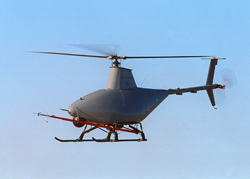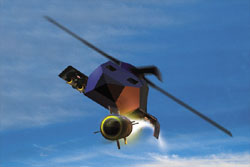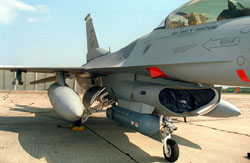Daily News
by Gail Helmer
[ Send Us News | Archives ]
Christmas Coverage
Your guide to Holiday activity on COMBATSIM.COM
It won't have escaped your notice that Christmas is approaching. Traditionally, the festive season is a quiet time for game news and reviews, so updates to COMBATSIM.COM are likely to be quite sparse for the next week or so.
Here's the guide to our Holiday plans:
Merry Christmas, everyone!
Blitzkrieg Movie Trailer
CDV Software has released their second movies of the three campaigns from its upcoming RTS Blitzkrieg. This week offers you a glimpse of the Russian campaign. The movie is 19MB in size and offers a nice mixture of historical material and 3D animation. Download
Military News
Northrop Grumman Continues Fire Scout Flight Test
Northrop Grumman Corporation's RQ-8A Fire Scout vertical takeoff and landing tactical unmanned system has achieved a series of milestones at Naval Air Station Patuxent River, Md., over the last five weeks, including significant expansion of its flight envelope and the initial flight of the first engineering and manufacturing development (EMD) air vehicle.
The Fire Scout system is in development and low-rate initial production for the U.S. Navy by Northrop Grumman's Integrated Systems sector as a force multiplier for naval forces at sea and Marine Corps forces ashore.

During the Nov. 14 envelope expansion flight, the P-3 demonstrator unmanned air vehicle (UAV) reached an altitude of 5,500 feet and flew at 60 knots (true air speed). Previously, the vehicle had reached an altitude of 3,800 feet and a speed of 30 knots.
During the Nov. 22 first flight of the E-1 EMD vehicle, the UAV demonstrated fully autonomous flight from engine start through shutdown.
The joint Navy/Northrop Grumman flight test team has now conducted more than 16 flights since October and more than 25 since testing began in May. The P-3 and E-1 air vehicles are both fully production configured. The latest flights included testing of the tactical common data link, demonstrating downlink of imagery to the Navy S-280 ground control station and uplink command and control during ground operations.
Flight testing resumed at NAS Patuxent River this week. Testing to date has focused primarily on full system autonomy from engine start to landing and engine shutdown, as well as ease of use by the air vehicle ground operators. The test team has included the participation of Navy and Marine Corps personnel as primary mission operators controlling the vehicle and its sensor payload on several flights.
All flight tests have been fully autonomous from engine start and takeoff through landing and engine shutdown. Autonomous control significantly decreases the chances of ground operator or "pilot" error since the operator can override the preprogrammed mission plan but is not required to manually control the air vehicle. That is especially important during shipboard landing operations under high sea state conditions.
Flying at altitudes up to 20,000 feet, Fire Scout employs an advanced payload with an electro-optical/infrared sensor including a laser designator/rangefinder to provide intelligence, reconnaissance and surveillance with pinpoint accuracy. This demonstrated system can provide military decision makers real-time information and targeting of enemy resources and personnel on the ground. The Fire Scout's communications suite allows simultaneous voice/data relay much farther than the "line of sight" limits of current systems that have lower maximum altitude ceilings.
Fully autonomous, Fire Scout was designed to meet mission requirements to fly high above deployed Marines and watch for threats within 150 nautical miles of the ground control station. The system would then direct Navy and Marine weapons accurately to the target with precise target location coordinates or the laser designator. Fire Scout has the flexibility to meet emerging Navy and Marine Corps requirements.
Northrop Grumman Completes UCAR Programme Review
Northrop Grumman Corporation's Integrated Systems sector has successfully completed a comprehensive program milestone review with the U.S. government on its unmanned combat armed rotorcraft (UCAR), concluding work for the first half of the program's initial phase.
UCAR, an advanced concept technology development program sponsored by the Defense Advanced Research Projects Agency (DARPA) and the U.S. Army, will provide enhanced reconnaissance and attack capabilities for Army aviation. It combines autonomous operations and advanced command and control technologies with the advantages of vertical takeoff and landing. Integrated with the Army's manned aircraft, the UCAR system will perform armed reconnaissance and attack missions, operating within the Army's Objective Force concept, effectively identifying and prosecuting targets that are camouflaged and concealed in close combat situations such as dense, mountainous and urban terrain.

In this initial stage of the four-phase, eight-year program, Northrop Grumman is conducting concept development and system tradeoff studies. During the November review, Northrop Grumman provided details about its progress toward demonstrating UCAR operational system capabilities, effectiveness analyses, preliminary total ownership cost estimates and initial program risk assessment.
Since the award in June 2002 valued at $3 million, Northrop Grumman has been evaluating a broad range of interrelated systems for mission management and control, support and UCAR air vehicles. These systems must come together in an overarching operational concept and architecture that will enable UCAR to operate seamlessly with other components of the Army's system-of-systems Objective Force construct.
The team has been considering a broad range of system architectures and on- and off-board sensors. By the next program milestone review, scheduled for February 2003, Northrop Grumman will have selected a single system concept for subsequent phases of the program.
Highly autonomous system capability, mission effectiveness and cost have been the driving factors in Northrop Grumman's tradeoff evaluations.
"We are building on the demonstrated effectiveness of our Global Hawk and Fire Scout unmanned systems to leap further ahead in autonomous control to develop a smart, affordable, lethal UCAR system with capabilities that are consistent with real-world Army operations," said Greg Zwernemann, Northrop Grumman's UCAR program manager.
After completion of the 12-month UCAR concept development phase, DARPA will select two contractors for a preliminary design concept development effort, which is expected to last nine months. The design concept development will be followed by a system development phase that will include the development and test of two demonstration vehicles. This will be followed by a system maturation phase, during which the contractor will develop and test a final system concept. The program is scheduled to transfer to the Army in 2009.
Northrop Grumman To Offer Litening AT
One of the most capable precision target designation and navigation systems currently available to U.S. and allied fighter pilots, Northrop Grumman Corporation's LITENING system, has been improved with the addition of enhanced video processing capabilities.
The upgraded system, known as LITENING Advanced Targeting (AT), makes use of new circuitry and algorithms that extend target detection range and improve target coordinate generation accuracy to support weapons guided by Global Positioning Systems (GPS).

LITENING AT is a self-contained, multisensor laser target designating and navigation system that enables fighter pilots to detect and identify ground targets for highly accurate delivery of both conventional and precision-guided weapons. In addition to improvements in its video processing capabilities, the LITENING AT also features enhanced algorithms that allow for multitarget cueing and enhanced air-to-air performance.
The LITENING AT is an upgrade to the LITENING Extended Range (ER) pod, which features a 640 x 512 pixel Forward-Looking Infrared (FLIR) camera; charge-coupled device television; laser spot tracker/range finder; IR marker; and a laser designator. The LITENING ER pod is itself an upgrade to the LITENING II pod.
[ Send Us News | Archives ]
by Gail Helmer
Thursday December 19, 2002
- Christmas Coverage
- Blitzkrieg Movie Trailer
- Northrop Grumman Continues Fire Scout Flight Test
- Northrop Grumman Completes UCAR Programme Review
- Northrop Grumman To Offer Litening AT
Christmas Coverage
Your guide to Holiday activity on COMBATSIM.COM
It won't have escaped your notice that Christmas is approaching. Traditionally, the festive season is a quiet time for game news and reviews, so updates to COMBATSIM.COM are likely to be quite sparse for the next week or so.
Here's the guide to our Holiday plans:
- Mon 23rd: normal service
- Tues 24th: some news, maybe, no articles
- Wed 25th and Thurs 26th: no news or articles
- Fri 27th and Mon 30th: we'll have a look
- Tues 31st and Wed 1st Jan: no news or articles
- Thurs 2nd Jan: normal service resumes
Merry Christmas, everyone!
Blitzkrieg Movie Trailer
CDV Software has released their second movies of the three campaigns from its upcoming RTS Blitzkrieg. This week offers you a glimpse of the Russian campaign. The movie is 19MB in size and offers a nice mixture of historical material and 3D animation. Download
Military News
Northrop Grumman Continues Fire Scout Flight Test
Northrop Grumman Corporation's RQ-8A Fire Scout vertical takeoff and landing tactical unmanned system has achieved a series of milestones at Naval Air Station Patuxent River, Md., over the last five weeks, including significant expansion of its flight envelope and the initial flight of the first engineering and manufacturing development (EMD) air vehicle.
The Fire Scout system is in development and low-rate initial production for the U.S. Navy by Northrop Grumman's Integrated Systems sector as a force multiplier for naval forces at sea and Marine Corps forces ashore.

During the Nov. 14 envelope expansion flight, the P-3 demonstrator unmanned air vehicle (UAV) reached an altitude of 5,500 feet and flew at 60 knots (true air speed). Previously, the vehicle had reached an altitude of 3,800 feet and a speed of 30 knots.
During the Nov. 22 first flight of the E-1 EMD vehicle, the UAV demonstrated fully autonomous flight from engine start through shutdown.
The joint Navy/Northrop Grumman flight test team has now conducted more than 16 flights since October and more than 25 since testing began in May. The P-3 and E-1 air vehicles are both fully production configured. The latest flights included testing of the tactical common data link, demonstrating downlink of imagery to the Navy S-280 ground control station and uplink command and control during ground operations.
Flight testing resumed at NAS Patuxent River this week. Testing to date has focused primarily on full system autonomy from engine start to landing and engine shutdown, as well as ease of use by the air vehicle ground operators. The test team has included the participation of Navy and Marine Corps personnel as primary mission operators controlling the vehicle and its sensor payload on several flights.
All flight tests have been fully autonomous from engine start and takeoff through landing and engine shutdown. Autonomous control significantly decreases the chances of ground operator or "pilot" error since the operator can override the preprogrammed mission plan but is not required to manually control the air vehicle. That is especially important during shipboard landing operations under high sea state conditions.
Flying at altitudes up to 20,000 feet, Fire Scout employs an advanced payload with an electro-optical/infrared sensor including a laser designator/rangefinder to provide intelligence, reconnaissance and surveillance with pinpoint accuracy. This demonstrated system can provide military decision makers real-time information and targeting of enemy resources and personnel on the ground. The Fire Scout's communications suite allows simultaneous voice/data relay much farther than the "line of sight" limits of current systems that have lower maximum altitude ceilings.
Fully autonomous, Fire Scout was designed to meet mission requirements to fly high above deployed Marines and watch for threats within 150 nautical miles of the ground control station. The system would then direct Navy and Marine weapons accurately to the target with precise target location coordinates or the laser designator. Fire Scout has the flexibility to meet emerging Navy and Marine Corps requirements.
Northrop Grumman Completes UCAR Programme Review
Northrop Grumman Corporation's Integrated Systems sector has successfully completed a comprehensive program milestone review with the U.S. government on its unmanned combat armed rotorcraft (UCAR), concluding work for the first half of the program's initial phase.
UCAR, an advanced concept technology development program sponsored by the Defense Advanced Research Projects Agency (DARPA) and the U.S. Army, will provide enhanced reconnaissance and attack capabilities for Army aviation. It combines autonomous operations and advanced command and control technologies with the advantages of vertical takeoff and landing. Integrated with the Army's manned aircraft, the UCAR system will perform armed reconnaissance and attack missions, operating within the Army's Objective Force concept, effectively identifying and prosecuting targets that are camouflaged and concealed in close combat situations such as dense, mountainous and urban terrain.

In this initial stage of the four-phase, eight-year program, Northrop Grumman is conducting concept development and system tradeoff studies. During the November review, Northrop Grumman provided details about its progress toward demonstrating UCAR operational system capabilities, effectiveness analyses, preliminary total ownership cost estimates and initial program risk assessment.
Since the award in June 2002 valued at $3 million, Northrop Grumman has been evaluating a broad range of interrelated systems for mission management and control, support and UCAR air vehicles. These systems must come together in an overarching operational concept and architecture that will enable UCAR to operate seamlessly with other components of the Army's system-of-systems Objective Force construct.
The team has been considering a broad range of system architectures and on- and off-board sensors. By the next program milestone review, scheduled for February 2003, Northrop Grumman will have selected a single system concept for subsequent phases of the program.
Highly autonomous system capability, mission effectiveness and cost have been the driving factors in Northrop Grumman's tradeoff evaluations.
"We are building on the demonstrated effectiveness of our Global Hawk and Fire Scout unmanned systems to leap further ahead in autonomous control to develop a smart, affordable, lethal UCAR system with capabilities that are consistent with real-world Army operations," said Greg Zwernemann, Northrop Grumman's UCAR program manager.
After completion of the 12-month UCAR concept development phase, DARPA will select two contractors for a preliminary design concept development effort, which is expected to last nine months. The design concept development will be followed by a system development phase that will include the development and test of two demonstration vehicles. This will be followed by a system maturation phase, during which the contractor will develop and test a final system concept. The program is scheduled to transfer to the Army in 2009.
Northrop Grumman To Offer Litening AT
One of the most capable precision target designation and navigation systems currently available to U.S. and allied fighter pilots, Northrop Grumman Corporation's LITENING system, has been improved with the addition of enhanced video processing capabilities.
The upgraded system, known as LITENING Advanced Targeting (AT), makes use of new circuitry and algorithms that extend target detection range and improve target coordinate generation accuracy to support weapons guided by Global Positioning Systems (GPS).

LITENING AT is a self-contained, multisensor laser target designating and navigation system that enables fighter pilots to detect and identify ground targets for highly accurate delivery of both conventional and precision-guided weapons. In addition to improvements in its video processing capabilities, the LITENING AT also features enhanced algorithms that allow for multitarget cueing and enhanced air-to-air performance.
The LITENING AT is an upgrade to the LITENING Extended Range (ER) pod, which features a 640 x 512 pixel Forward-Looking Infrared (FLIR) camera; charge-coupled device television; laser spot tracker/range finder; IR marker; and a laser designator. The LITENING ER pod is itself an upgrade to the LITENING II pod.
